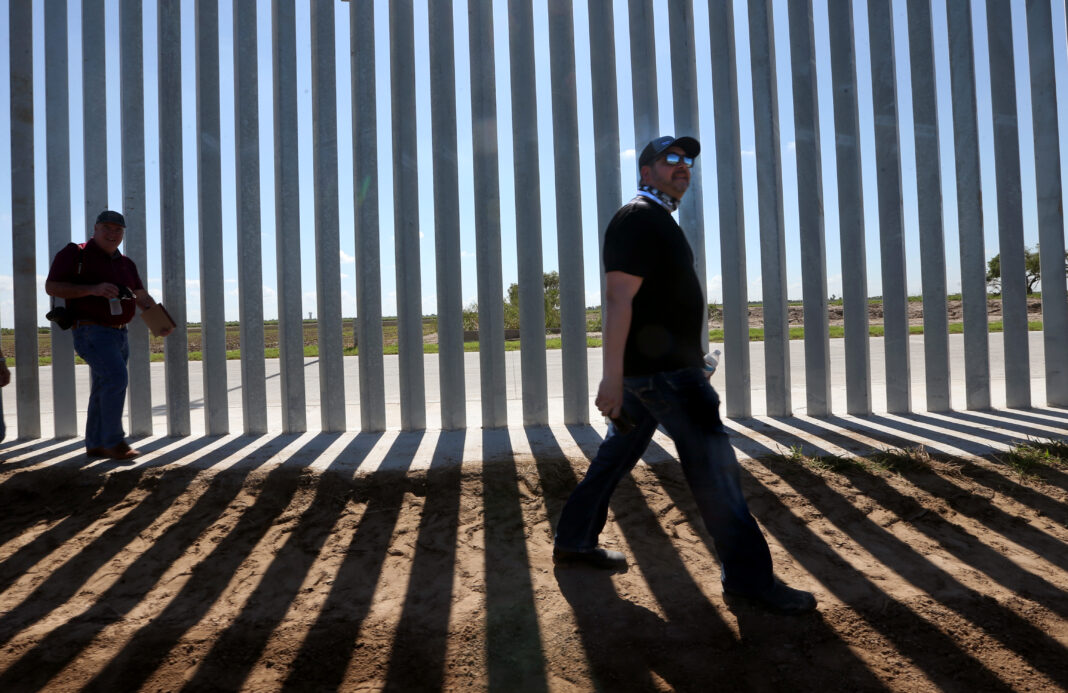The federal government is close to reaching a settlement agreement with the builder of a 3-mile stretch of private border wall along the banks of the Rio Grande south of Mission.
The announcement came during a status conference in McAllen federal court Friday morning.
“I believe that we are close to having everything done. I mean, we are within just a few paragraphs of having the settlement completed so that we can then get that over to the State Department and get approval,” Assistant U.S. Attorney Eric Paxton Warner said at the top of the discussion.
“We got a lot of the engineering data done this week, and so it’s just a matter of putting it into words and getting it back and forth. You know, it’s some different triggering mechanisms on so many things like that,” he added a moment later.
An attorney for Tommy Fisher, the North Dakotan whose companies, Fisher Sand and Gravel and TGR Construction erected the galvanized steel bollards along the riverbank, agreed with Warner’s assessment.
“We’re in full agreement with the government and with what Mr. Paxton just represented to the court. We’re very close to getting this thing done and we want to be able to push it over the finish line,” Mark Courtois said.
Warner asked the court for an additional 60 days to finish hammering out the final details of the agreement, which U.S. District Judge Randy Crane granted.
If things go according to plan, the government’s lawsuit against Fisher and his companies will come to an end — without a trial — more than two years after it was filed.
Reached by phone Friday afternoon, Fisher was optimistic, though he remained cautious about celebrating before the dotted line has been signed.
“Yeah, I think it’s good news for everyone,” Fisher said.
“We feel working with IBWC, you know, and looking at their concerns and stuff, working together, that’s all we want to do is just make sure that we have something built that’s gonna do what it needs to do, and is gonna function in any types of these weather events and take a lot of the misinformation away,” he said.
The “misinformation” Fisher alluded to are allegations that the structure isn’t stable and that it will eventually collapse, especially after evidence of severe erosion was seen leading up to the wall’s foundation just months after it was built.
The federal government, on behalf of the International Boundary and Water Commission, sued Fisher and a host of other defendants in December 2019 — before the wall had gone up. It alleged that the wall would put the United States in violation of a 1970 international boundary treaty with Mexico.
The government ultimately dropped several co-defendants from the suit, including former landowners, Neuhaus and Sons, as well as Iraq War veteran Brian Kolfage and his fundraising nonprofit, We Build the Wall.
That left just Fisher and his companies involved in the litigation as it stalled for months, and as the judge held hearings in tandem with another filed against Fisher.
That second lawsuit was filed by the National Butterfly Center, which owns a 100-acre preserve just west of the private border wall. The center alleged the wall would infringe upon its private property rights, and also that the defendants had defamed Marianna Trevino Wright, the center’s executive director.
Just last month, the butterfly center dropped the land rights portion of its lawsuit after Crane declined to remand that portion to state court, where the butterfly center argued jurisdiction lay.
Instead, Crane had sent only the defamation portion of the butterfly center’s case back to state court.
One of the other factors that contributed to the butterfly center dropping its lawsuit against Fisher was its inability to obtain an engineering report conducted by the global firm, Arcadis, at the behest of the federal government in its own suit.
Though Crane had repeatedly encouraged the center to request the report from Fisher’s attorney, that attorney, Courtois, said he had been instructed not to turn it over.
That instruction had come from Warner, Courtois said in court and later confirmed during conversations with the center’s attorney, Javier Pena.
Pena argued that a government-produced report could not be withheld to a third party, and went as far as accusing the government attorneys of doing so to conceal evidence.
“They are without a doubt concealing evidence. Against the rules of evidence, against everything. They’ve got no justifiable legal reason to request that a third party withhold those documents, but they’re doing it,” Pena said last month.
In the end, the butterfly center and its attorney felt the court was acting more favorably toward Fisher and the defendants in a manner that could affect the butterfly center’s ability to prevail.
“The judge basically gave a roadmap to the other side about how to get the case dismissed, so after a long conversation with my clients, we decided just to drop it,” Pena said.
But it’s that very same engineering report — which remains shrouded in secrecy — that Fisher points to as evidence of why he and the government are so close to settling.
“With all the information the government has and all the information that we provided, I think we’re at a meeting of the minds that the, you know what I’m saying, the wall works with certain consideration,” Fisher said.
Fisher declined to speak to specifics of the report’s findings, however, saying he wasn’t familiar with its intricacies because he depends on briefings from his engineers and attorneys.
Reiterating his sense of caution, Fisher said he was looking forward to concluding the litigation with a settlement.
“If that ultimately happens, we’re glad to reach a settlement with IBWC. And maybe that leads the way for other property owners if they so choose to, you know, protect their land however they choose to protect it as long as it falls within the rules and regulations,” Fisher said.




